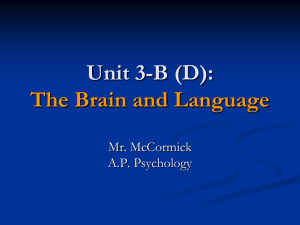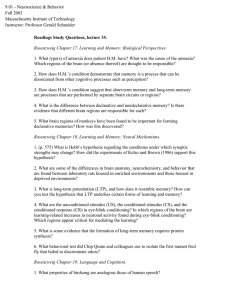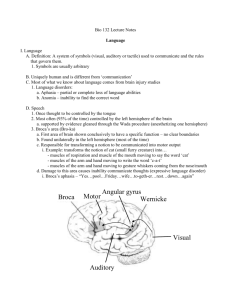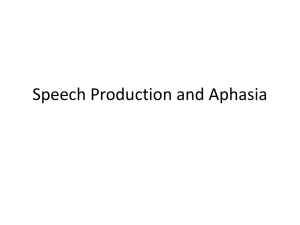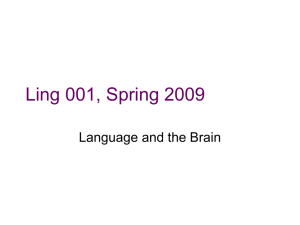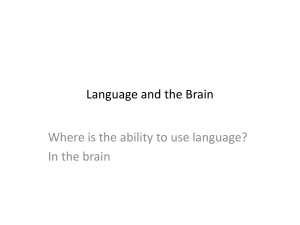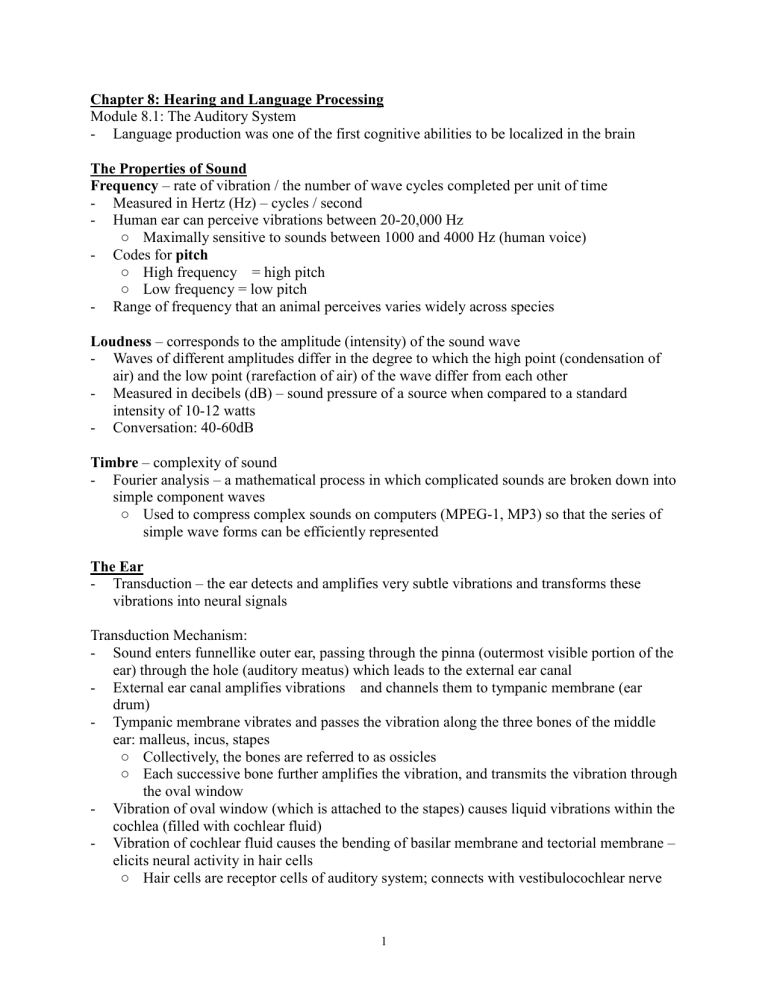
Chapter 8: Hearing and Language Processing Module 8.1: The Auditory System - Language production was one of the first cognitive abilities to be localized in the brain The Properties of Sound Frequency – rate of vibration / the number of wave cycles completed per unit of time - Measured in Hertz (Hz) – cycles / second - Human ear can perceive vibrations between 20-20,000 Hz ○ Maximally sensitive to sounds between 1000 and 4000 Hz (human voice) - Codes for pitch ○ High frequency = high pitch ○ Low frequency = low pitch - Range of frequency that an animal perceives varies widely across species Loudness – corresponds to the amplitude (intensity) of the sound wave - Waves of different amplitudes differ in the degree to which the high point (condensation of air) and the low point (rarefaction of air) of the wave differ from each other - Measured in decibels (dB) – sound pressure of a source when compared to a standard intensity of 10-12 watts - Conversation: 40-60dB Timbre – complexity of sound - Fourier analysis – a mathematical process in which complicated sounds are broken down into simple component waves ○ Used to compress complex sounds on computers (MPEG-1, MP3) so that the series of simple wave forms can be efficiently represented The Ear - Transduction – the ear detects and amplifies very subtle vibrations and transforms these vibrations into neural signals Transduction Mechanism: - Sound enters funnellike outer ear, passing through the pinna (outermost visible portion of the ear) through the hole (auditory meatus) which leads to the external ear canal - External ear canal amplifies vibrations and channels them to tympanic membrane (ear drum) - Tympanic membrane vibrates and passes the vibration along the three bones of the middle ear: malleus, incus, stapes ○ Collectively, the bones are referred to as ossicles ○ Each successive bone further amplifies the vibration, and transmits the vibration through the oval window - Vibration of oval window (which is attached to the stapes) causes liquid vibrations within the cochlea (filled with cochlear fluid) - Vibration of cochlear fluid causes the bending of basilar membrane and tectorial membrane – elicits neural activity in hair cells ○ Hair cells are receptor cells of auditory system; connects with vestibulocochlear nerve 1 Anatomical Divisions of the Ear: - Outer Ear – pinna, external ear canal ○ Catches and amplify sound waves - Middle Ear – chamber between tympanic membrane and oval window ○ Sound waves are transduced from variations in air pressure into mechanical energy that is propagated and amplified along the ossicles to the oval window - Inner Ear – mechanical energy is turned into neural activity ○ Cochlea – contains inner hair cells and outer hair cells Outer hair cells outnumber inner hair cells by 3:1 Inner hair cells serve as receptors for auditory system; only 5% of auditory nerve cells receive inputs from outer cells Outer hair cells – modulatory role; helps to “tune” the cochlea through contraction and relaxation - - - Inner Hair Cells (auditory receptors) have tiny filaments at their tips – cilia that are arranged in order of height ○ Tallest cilia – kinocilium ○ When cilia move toward direction of kinocilium: Fibers are stretched, increased firing in axons of cochlea nerve ○ When cilia move away from kinocilium (in very quiet situations): firing in cochlear nerve falls below the normal (resting) rate ○ Organ of Corti: Hair cells + their cilia + support cells Different parts of the cochlea respond maximally to different frequencies ○ Basilar membrane closest to oval window is quite stiff, receptors are exposed to higher frequencies ○ Near the helicotrema (apex), the basilar membrane is more flexible, receptors are exposed to lower frequencies Different projections from the cochlea demonstrate different activation under different attentional conditions ○ Inner ear functions can be affected by higher perceptual and attentional pathways Auditory Pathways Pathway #1 1. Axons of cochlear nerve form a branch of vestibulocochlear nerve which synapses on the ipsilateral cochlear nuclei 2. Pathway A: Most projects lead to ipsilateral or contralateral superior olives ○ Projections travel ipsilaterally to the inferior colliculus Pathway B: some lead directly to inferior colliculus of the midbrain 3. At the inferior colliculus, ○ Some projects cross the to the contralateral side – eventually projects to medial geniculate nucleus of thalamus, then to primary auditory cortex ○ Some project to the medial geniculate nucleus of the thalamus, then to primary auditory cortex - Unlike visual system, auditory projections do not necessarily terminate in the cortex 2 contralateral to their origins ○ Projections may cross contralaterally at the level of cochlear nuclei and at level of inferior colliculus ○ Majority of all auditory projections are exclusively ipsilateral ○ Most fibres cross sides before the projections reach the cortex Pathway #2 1. Axons of cochlear nerve form a branch of vestibulocochlear nerve which synapses on the ipsilateral cochlear nuclei 2. Pathway A: Most projects lead to ipsilateral or contralateral superior olives ○ Projections travel ipsilaterally to the inferior colliculus Pathway B: some lead directly to inferior colliculus of the midbrain 3. At the inferior colliculus, projections synapse on the dorsal medial geniculate nucleus of the thalamus, then project directly to the secondary and tertiary auditory cortices (BA42, BA22) Auditory Cortex Primary Auditory Cortex - Neurons within the primary auditory cortex are highly specialized to respond to certain frequencies of sound - Is organized in a tonotopic fashion – has a frequency-specific sensory organization ○ Neurons are arranged in columns Columns in more anterior regions of cortex respond maximally to higher frequencies Neurons in posterior regions respond more to lower frequencies ○ Cortical neurons respond to a narrower range of frequencies than do the neurons located earlier in the processing stream (e.g. Cochlea) - Most right-handers have a right primary auditory cortex that is larger than the left Secondary Auditory Cortex - Areas immediately adjacent to the primary auditory cortex; is located lateral and anterior to the primary auditory cortex - Neurons in this region appear to be highly selective in the stimuli to which they respond ○ Highly sensitive to specific frequencies of sound, and sensitive to frequencies occurring in particular temporal patterns Module 8.2: Language Systems in the Brain - Studies of language can be done in the normal, intact brain Models of Spoken Language - Language processing was thought to be a unitary function, all of which were subserved by a single module in the brain ○ Supported by Gall and Spurzheim ○ Broca – language was subserved by the frontal lobe (third gyrus of left frontal lobe – Broca’s Area) - Wernicke – suggested that one area was responsible for the output of spoken language 3 - - (Broca’s area) and another area was responsible for mapping sounds to words (Wernicke’s area) ○ Wernicke’s area – located in the left temporal lobe, just posterior to the primary auditory cortex ○ Broca’s area and Wernicke’s area need to be connected to provide meaningful verbal output Connection = arcuate fasciculus Lichtheim (1885) – Wernicke-Lichtheim model ○ Wernicke’s area maps sounds to words but its role in ascribing meaning to those sounds is minimal ○ Concept centre ascribes meanings to sounds; connected to both Broca’s and Wernicke’s area ○ Explained more of the language disorders than Wernicke’s original model, but is still a gross oversimplification of language processing ○ Accounted for oral and aural language (that which is spoken and heard), but did not account for visual language (reading and writing) Norman Geschwind – produced the Wernicke-Lichtheim-Geschwind (WLG) model ○ Angular gyrus - receives projections from primary and visual areas, provides a basis for visual language Located at the junction between the temporal, parietal, and occipital lobes ○ Accounts for many aspects of normal speech Spontaneous speech is produced by accessing the mappings of sounds to the meanings in Wernicke’s area, projecting this information via the arcuate fasciculus to Broca’s area, wherein the motor program is formulated and executed through the primary motor cortex that innervates the mouth, tongue, and so on ○ Accounts for some processing of visual language information Suggests that the Wernicke’s area processes information in a similar way for visual language information as it is presented with “real” auditory stimulation ○ Support for WLG model Provides a parsimonious account of many of the clinical speech disorders Confirmed by electrical stimulation and functional neuroimaging studies ○ Disadvantages: oversimplification and omission Oversimplifies processing of visual language Models of Visual Language - Differences between auditory and visual language: ○ Different modalities are employed ○ Auditory language abilities usually develop long before visual language does Auditory language is developed with relative ease; progresses well without formal instruction Visual language – explicitly taught; acquisition is not effortless - Current visual language models are classified into two general classes: ○ Single-route models – both types of reading can be subserved by a single distributed network ○ Dual-route models – there are 2 functionally distinct routes for receptive visual language: Phonological Route, Whole-Word Route 4 - - ○ Both classes of models describes two ways in which words can be read: sounding out the words or reading the word as a whole Phoneme-grapheme conversion rules ○ Phoneme – a small, pronounceable, and meaningful unit of sound in language ○ Grapheme – smallest units of written language; letters ○ When words are unfamiliar, they must be pronounced by using phoneme-grapheme rules; once they become familiar, their graphemic representation is “remembered” as a whole Pseudo-homophones – letter strings that form sounds like real words ○ Eg. “Hukt awne foniks wurkt phore mee” Prosody and the Role of the Right Hemisphere in Language Processing - Prosody – the conveyance of meaning by varying the intonation in speech, including changes in pitch, tempo, intensity, and rhythm ○ Can augment the meaning of the words in a phrase ○ Can reverse the meaning of words (eg. In sarcasm) ○ Can cue the presence of a question – by a slightly elevation in pitch toward the end of a phrase ○ Can convey the meaning of single words ○ Can infer the speaker’s emotional state ○ Right hemisphere is specialized for detection of prosody - Differences in prosody presentation: ○ Large individual and cultural differences in the amount and type of prosody employed during conversation ○ Sex differences – males employ higher rates of speech, more narrow pitch ranges, but a greater pitch slope (rate of pitch change) than those of female speakers Module 8.3: Disorders of Language and Auditory Perception Aphasia - Aphasia – “lack of language”, “no language” ○ Deficit this severe is extremely rare ○ Most who are diagnosed retain some (or even much) of their linguistic capacity - Dysphasia – partial loss of language - The different types of aphasia vary considerably in their severity and the deficits are almost never complete – some functionality of the impaired system or structure is virtually always retained Broca’s Aphasia - Symptoms: ○ Inability to produce fluent speech, despite relatively intact speech comprehension and intact vocal mechanisms - Verbal problems evident are not the result of a generalized inability to produce oral-facial movements – can blow out a candle or clear his or her throat - Do not exhibit generalized cognitive impairments 5 - - - - ○ Performance on nonverbal tasks remains in the normal range ○ Ability to understand and carry out verbal commands is preserved Anomia – the inability to find the correct word (usually nouns and verbs) ○ People w/ Broca’s aphasia often exhibit some degree of anomia, but most exclusions are function words Results in speech that is composed mostly of nouns, verbs, and some adjectives Telegraphic speech Usually displays agrammatism but types of errors are usually errors of omission ○ Agrammatism – inability to produce grammatically correct sentences ○ Not limited to production of speech – understanding of function words can be impaired ○ Compromises language comprehension only under certain circumstances – semantics (meaning of words) may allow aphasics to understand the meaning of the sentences Phonemic paraphasia – often substitute similar sounds with a word ○ Have difficulty producing the correct phoneme ○ Errors that are made appear to vary systematically with the physical requirements of producing a particular sound – makes errors based on the place of articulation Lesions located at BA44 and BA45 Exhibits problems in solving nonverbal planning tasks – problem of mental sequencing which is necessary both for language production and for planning in a more general sense Wernicke’s Aphasia - Fluent speech, but the meaning of the speech is severely compromised ○ Word salad – random collection of words that form speech from an individual with Wernicke’s aphasia ○ Speech includes many sensible orderings of the different parts of speech - Can appear without any motor deficit - Produces speech effortlessly but exhibit severe deficits in speech comprehension ○ Juxtaposition of effortless fluency with a lack of meaningful content - Paraphasia is more severe than Broca’s aphasia ○ Makes more semantic paraphasic errors (substituting an incorrect word for the intended word) ○ Makes some phonemic paraphasic errors (substation of similar sounds with words) - Are unable to correctly match linguistic sounds with their meanings - When they attempt to converse, the words they produce might contain some of the wrong phonemes (phonemic paraphasic error), or a different word entirely might be substituted in its place (semantic paraphasic error) - Appearances of neologisms in speech – sounds that a word comprises are combined in a way that sounds like words (eg. Biznit, scrut, almod) - Seem completely unaware of their deficit – fails to detect the errors in their own speech, do not notice that they no longer understand the speech of others ○ Makes them appear much less impaired than they actually are - Allowed Wernicke to claim that the temporal lobe contained the memories for how sounds correspond to words and other subjects, whereas the frontal lobe served to help produce the necessary movements to create language sounds 6 - - Damage restricted to left frontal language area ○ Difficulties producing speech ○ Memories for sound images should be intact; comprehension of speech should be unaffected Damage to temporal lobe ○ Impairments in comprehension and the meaningful production of speech despite preserved articulation Conduction Aphasia - Leitungsaphasia - Damage to arcuate fasciculus (damage to inferior parietal lobe that is deep enough to penetrate the arcuate fasciculus) that connects Broca’s area and Wernicke’s area – disrupts the flow of information from one’s knowledge of how sounds map onto words and one’s knowledge about how to create such sounds ○ Both Wernicke’s and Broca’s areas are intact – comprehension and production are spared - Results in an impairment in repetition despite fluent and meaningful spontaneous speech ○ Speech contains phonemic paraphasias - Other areas of damage that may give rise to conduction aphasia: ○ Damage to blood supply around the arcuate ○ Highly local infections or tumours ○ Damage to the posterior sylvian region – may or may not include damage to the supramarginal gyrus and underlying white matter ○ Damage to Wernicke’s area ○ Damage to angular gyrus Transcortical-Motor Aphasia - Retains their ability to repeat words and phrases - Often mistakenly identified as Broca’s aphasia – spontaneous speech is halting and laborious, comprehension I intact - Articulation is not impaired when the person is instructed to repeat words or phrases - Echolalia – exhibits a compulsion to repeat whatever someone else just said ○ Don’t need instructions to repeat words or phrases - Can be triggered by damage to a variety of structures but all of these lesions involve a disruption to the connections between the dorsolateral prefrontal cortex and the anterior portion of the Broca’s area ○ Results in a disconnection between Broca’s area and the supplementary motor area ○ Depending on the exact location of the lesion, other motor deficits can result ○ Connection between Wernicke’s area and Broca’s area remains intact – facilitates compulsive repetition Transcortical-Sensory Aphasia - Analogous to Wernicke’s aphasia with spared repetition - Similar fluent but nonsensical speech, riddled with paraphasias and neologisms - Verbal comprehension is severely compromised - Oral naming of objects is sometimes preserved 7 - Unimpaired at repetition – echolalia Caused by lesions to the angular gyrus, frontal lesions, or thalamic lesions Observed during the latter stages of Alzheimer’s disease Arcuate fasciculus remains intact – underlies the preserved repetition or even echolalia Mixed Transcortical Aphasia - Results from presence of two lesions: ○ Frontal lobe lesion that spares much of the Broca’s area ○ Lesion that damages temporal structures - Clinically, shares the symptoms of both Transcortical-motor aphasia and Transcortical-sensory aphasia ○ Halting, laborious, and meaningless speech ○ Impaired auditory comprehension ○ Preserved repetition and echolalia - Suggested that disorder appears only when the right hemisphere is capable of subserving some residual language function ○ The occurrence of a second lesion in the right hemisphere can eliminate the ability to repeat ○ Injecting amobarbital into the right hemisphere of a mixed Transcortical aphasic can impair repetition Global Aphasia - Most severe of the aphasias - Global impairment of language comprehension and production ○ Speech is meaningless and nonfluent (halting, laborious) ○ Comprehension is impaired ○ Repetition is not spared ○ Hemiparesis often accompanies the language deficits - Lesions that give rise to this condition are extensive: ○ Broca’s area ○ Wernicke’s area ○ Many of the cortical and subcortical structures in between Broca’s area and Wernicke’s area ○ Often caused by damage to middle cerebral artery ○ Lesions don’t have to involve Wernicke’s area or Broca’s area – completely subcortical lesions can produce the disorder Anomic Aphasia - Produces meaningful, fluent speech with preserved repetition but impaired word finding - Circumlocution – the person may talk in circles around what he or she is really trying to say to trigger their memory for the word by talking about related matters - Results from lesions to a variety of locations ○ Lesion to Wernicke’s area – resulting anomia can still be fluent ○ Lesion includes Broca’s area or more posterior areas – fluency is impaired, and agrammatism may occur 8 Pure Word Deafness - Inability to understand spoken language despite preserved speech, reading, and writing ○ Can accurately perceive other noises, including music - Extremely rare - Individuals are quite aware of their deficits – indicates that speech is incomprehensible and sounds as if it is a foreign language ○ Might complain that others are speaking too quietly or quickly - Caused by bilateral lesions to the posterior superior temporal lobe, close to (or including) its border with the parietal lobe) Auditory Sound Agnosia - Resembles pure word deafness ○ Displays relatively little trouble perceiving words but have great difficulty in identifying environmental sounds - Apperceptive causes – perceptual problems ○ Individuals confuse two perceptually similar sounds (both structurally and acoustically) - Are relatively unimpaired at associating linguistic sounds with meaning Subtypes of Acquired Alexia Acquired alexia – reading disorders that appear as a result of brain damage in people who previously demonstrated normal reading abilities - Alexia / Dyslexia – a lack of reading ability - Rarely pure – often some reading ability is retained Phonological Alexia (letter alexia) – reader is unable to attribute the correct sound (phoneme) to the graphemes in the written material - Individual cannot sound out unfamiliar words but can recognize common words - Makes errors in the form of visual paralexias – substitutes two similar looking words (eg. Leaf and lead) - Explained with dual-route model of reading ○ If an individual suffers damage to the phonological route, the intact, whole-word route can still subserve the reading of both regular and irregular words - Damage to posterior inferior temporal lobe Surface Alexia – impairment in reading irregular words but spared reading of regular words or even nonwords - Explained in dual-route model of reading ○ If an individual suffers damage to the whole-word processing route, the intact phonological route can successfully process regular words and unfamiliar words, but it cannot produce the correct pronunciation of irregular words ○ Relying exclusively on phonological processing route causes confusion of the meanings of written words that sound the same as other words with different meanings (homophones) Deep Alexia – reading regular and irregular is relatively unimpaired, but reading nonwords is 9 profoundly impaired - Semantic paralexias – substitutes words with semantically similar ones during reading - Relative inability to read words that are not highly imageable – incl. words that describe abstract concepts and very common function words Alexia without Agraphia Agraphia – inability to write - Loss of ability to write must not be attributable to basic sensory or motor problems or a more generalized intellectual impairment - Both alexia and Agraphia normally follow lesions to the angular gyrus at the posterior superior temporal and inferior parietal junction - Agraphia can occur in the absence of alexia and vice versa - Often complain of visual problems – attribute problem to a visual disturbance - Underlying problem: disconnection between visual perception and memory for orthographic representations of words ○ If words are spelled out loud or traced into their palms, the affected individuals can often identify the words; memories of orthography of the words are intact Agraphia without Alexia - Loss of ability to write despite retaining their ability to read Subtypes of Acquired Agraphia Phonological Agraphia – inability to write a word on the basis of “sounding it out”, despite the ability to write both regular and irregular words - Can be diagnosed by asking an individual to write nonwords - Explained by dual-route model of writing in which the individual suffers damage along the phonological rote, but the intact whole-word route is able to subserve the writing of words with preformed orthographic memories Surface Agraphia – inability to write irregular words (eg. yacht or colonel) despite the ability to write regular words and nonwords by “sounding them out” - Explained by dual-route model of reading: whole-word route is damaged, intact phonological route can subserve the writing of words or nonwords that follow phoneme-grapheme correspondence rules Deep Agraphia – individuals cannot write words on the basis of phoneme-grapheme correspondence rules - Involves semantic paragraphias – semantically related substitutions in writing - Can occur in the absence of semantic paragraphias in reading - Difficult to explain by dual-route models of reading ○ Probably involves damage along the phonological route but might also involve lesions disconnecting (or partially disconnecting) the whole-word route from the semantic center Aprosodias - Loss of ability to produce or comprehend prosody in speech, which usually follows right 10 - hemisphere damage Motor aprosodia – anterior lesions tend to impair the production of prosody; analogous to Broca’s aphasia Sensory aprosodia – posterior lesions selectively impair the comprehension of prosody; analogous to Wernicke’s aphasia Conduction aprosodia – both spontaneous production and comprehension are intact, but repetition is impaired Transcortical-sensory aprosodia – spontaneous production and repetition are intact, but comprehension is impaired Transcortical-motor aprosodia – prosodic comprehension and repetition are intact, but spontaneous production is impaired Emotion is experienced privately, within the self, but the emotional state of an individual can be communicated to others ○ Humans have both the perception and experience of the emotional state in the self and the perception of the emotional state of others ○ Humans also perceives that others cannot truly understand the nature or depth of a person’s emotions, because they are subjective and personal 11
